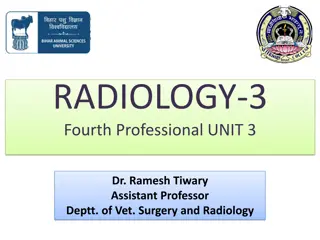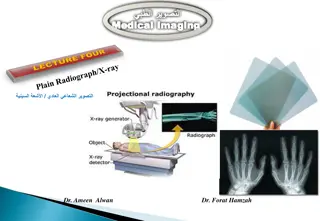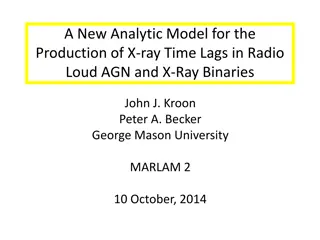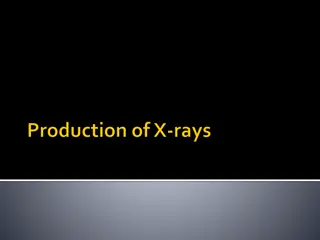Understanding the Components of an X-Ray Machine
An X-ray machine consists of vital components like the x-ray tube, power supply, cathode, and anode. The x-ray tube houses the cathode and anode, which are responsible for generating x-rays. The cathode includes a filament heated to emit electrons, while the anode has a target to convert electron energy into x-ray photons. These components work together within an evacuated glass envelope to produce high-quality diagnostic x-ray images.
Download Presentation

Please find below an Image/Link to download the presentation.
The content on the website is provided AS IS for your information and personal use only. It may not be sold, licensed, or shared on other websites without obtaining consent from the author. Download presentation by click this link. If you encounter any issues during the download, it is possible that the publisher has removed the file from their server.
E N D
Presentation Transcript
X-Ray machine It consists of x ray tube and its power supply X ray tube is positioned within the tube head, along with some components of power supply Tube head is supported by an arm that is usually mounted on a wall A control panel allows the operator to adjust the time of exposure
X-ray tube X ray tube is composed of a cathode and anode Cathode serves as the source of electrons that flow to the anode When electrons from cathode strike target in anode, they produce x rays Power supply: 1. to heat the filament to generate electrons 2. Establish a high voltage potential b/w anode and cathode to accelerate the electrons Cathode and anode lie in an evacuated glass envelope or tube
Cathode It consists of a filament and a focusing cup Filament is the source of electrons within the tube It is a coil of tungsten wire about 2 mm in diameter and 1cm or less in length It is mounted on two stiff wires that support it and carry the electric current These 2 mounting wires lead through the glass envelope and connect to both the high and low voltage electrical sources
Filament is heated to incandescence by the flow of current from the high voltage source and emits electrons at a rate proportional to temperature of filament Filament lies in a focusing cup, a negatively charged concave reflector made of molybdenum Focusing cup electrostatically focuses the electrons emitted by filament into a narrow beam directed at a small rectangular area on anode called focal spot
The x ray tube is evacuated to prevent collision of moving electrons with gas molecules, which significantly reduces their speed This also prevents oxidation and burn out of the filament
Anode It consists of a tungsten target embedded in a copper stem Purpose of target is to convert kinetic energy of electrons generated from the filament into x ray photons Target is made up of tungsten, which has ideal characteristics: 1. High atomic no, 74, more efficient in producing x rays 2. High melting point 3. High thermal conductivity 4. Low vapor pressure, at high temperatures helps maintain vacuum in the tube at high operating temperatures
Tungsten target is typically embedded in a large block of copper to dissipiate heat and thus prevents target melting Insulating oil b/w the glass envelope and the housing of the tube head carries heat away from the copper stem
Focal spot It is the area on the target to which the focusing cup directs the electrons from the filament To take advantage of a small focal spot while distributing the electrons over a larger area of target, target is placed at an angle to the electron beam Projection of the focal spot perpendicular to the electron beam, effective focal spot is smaller than actual size of focal spot Target is inclined at 20 degrees to CR of x ray beam, which causes EFS 1x1, whereas actual spot is 1x3mm
The effect is a small apparent source of x rays and an increase in image sharpness with a larger actual FS for heat dissipation Rotating anode: target s in the form of a beveled disk that rotates when tube is in operation The electrons strike successive areas of the target, widening the FS by an amount corresponding to the circumference of the beveled disk and distributing the heat over this expanded area
Power supply Primary function: 1. Provide a low voltage current to heat the x ray tube filament by use of a step down transformer 2. Generate a high potential difference between anode and cathode by use of a high voltage transformer The transformers and x ray tube lie within an electrically grounded metal housing called the head of the x ray machine An electrical insulating material, usually oil, surrounds the transformers
Tube current Filament step down transformer reduces the voltage of the incoming alternating current to about 10 volts Its operation is regulated by filament current control, mA switch mA switch adjusts the resistance and thus the current flow through the low voltage circuit, including the filament This in turn regulates the temperature of the filament and thus the number of electrons emitted It is the flow of electrons through the tube i.e., from the filament to the anode and then back to the filament through the wiring of power supply
TUBE VOLTAGE A high voltage is required b/w anode and cathode to generate x rays An autotransformer converts the primary voltage from the input source into the secondary voltage secondary voltage is regulated by kVp selector dial kVp dial selects a voltage from different levels on autotransformer and applies it across the primary winding of the high voltage transformer It controls the voltage b/w anode and cathode of x ray tube
The high voltage transformer provides the high voltage required by the x ray tube to accelerate the electrons from the cathode to the anode and generate x rays It accomplishes this by boosting the peak voltage of the incoming line current to as high as 60 to 100 kv, thus boosting the peak energy of electrons passing through the tube to as high as 60 to 100 keV kVp selector dial setting thus determines the peak kV across the tube
Coz the line current is AC, polarity of x tube alternates at the same frequency When polarity of voltage applied across tube causes the target anode to be positive and filament negative, electrons around filament accelerate toward the positive target and current flows through the tube The line voltage is variable, voltage potential b/w anode and cathode varies As tube voltage is increased, speed of electrons increases X rays are produced with greatest efficiency, when voltage applied is high The intensity of x ray pulses tends to be sharply peaked at centre of each cycle
During the following half of cycle, polarity of AC reverses and filament becomes positive and target negative and electrons stay in vicinity of filament and do not flow across the gap inverse voltage or reverse bias When an x ray tube is powered with 60-cycle AC, 60 pulses of x rays are generated each second, each with a duration of 1/120 second This AC cycle limits x ray production to half of AC cycle and is called self rectified or half wave rectified
Timer A timer is built into high voltage circuit to control the duration of x ray exposure It controls the length of time that high voltage is applied to tube and therefore the time during which current flows and x rays are produced Filament must be brought to operating temperature to ensure an adequate rate of electron emission Filament cannot be subjected to continuous heating coz of long period heating may shorten its life The timing circuit first sends a current through the filament for about half a second to bring to proper operating temperature After the filament is heated, timer then applies power to high voltage circuit
Tube rating and duty cycle Tube rating specifications describes the maximal exposure time the tube can be energized without risk of damage to target from overheating These are described in graph form the maximal safe intervals (seconds) that the tube can be used for a range of voltages and filament current values Duty cycle relates to the frequency with which successive exposures can be made The heat build up at the anode is measured in heat units defined by kVpxmAx seconds























